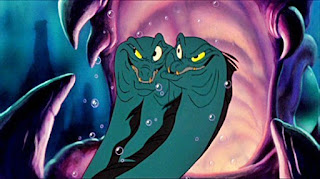Marine Creature of the Month Nov'19
Marine Creature of the Month
Famous Fish
 |
| Picture from Kingdom Hearts Wiki |
Flotsam & Jetsam
AKA Moray Eels
I thought it would be prudent to do my next famous fish in keeping with my Hallowe'en costume. I can get away with this a week into November, right? Christmas starts on the 25th of this month, at the earliest.
Kingdom: Animalia
Class: Actinopterygii
Conservation Status: Least Concern (LC)
WHAT IS IT?
A moray eel is a very long eel, found in warm and temperate waters across the world. They range in size from 11cm to 4m (4" to 13ft). That is well over twice the length (height) of the average human. Moray eels are fish, despite their somewhat reptilian look, and there are roughly two hundred species - hence the vast difference in size. The come in a variety of colours as well as sizes, but all share a distinctive shape. They all have an elongated body with a flattened tail, as well as their lamp-like eyes and a mouth full of teeth. (At least real moray eels can't use magic to let their sea witch mistress spy on you!)
And unlike Ursula's, moray eels comes in a beautiful array of colours and patterns, as you'll see in the pictures below. They can be striped, spotted, or even have spotted stripes; and they range in colour from grey to orange.
WHERE DO THEY LIVE?
Moray eels can be found in nearly all waters, they only shy away from the cold, polar regions. They are most commonly found in shallow, tropical climates, winding their long bodies around the reefs. However, they can be found in brackish water (slightly salty) and even a few in fresh water. There are also a few species which live in much deeper waters, among crevices down there. Most species live in the more tropical waters, along the equator, in dead patches of reef rather than among the living coral.
 |
| Photo from Unsplash |
WHAT DO THEY HUNT?
If the teeth weren't a massive give away, they are carnivores. They eat squid, crustaceans, and other fish - so say goodbye to all of Ariel's sidekicks. They are opportunistic eaters. Their diet varies across the different species, each having evolved teeth which best suit their prey. Those which feed mostly on crustaceans will have more molar-like teeth, whereas those which need to tear through flesh will have sharper and pointier teeth.
Part of what makes moray eels so iconic is their jaw. They have a pharyngeal jaw, which is a second set of mini jaws set further back in their mouth. They are the only animal to actively use them to capture and restrain their prey. When hunting, they open their mouths really wide which lets the pharyngeal jaws align with the rest of their jaw, so they can bite down on their prey. The style of the teeth on the pharyngeal jaw matches the rest in the eel's mouth, meaning they too are designed for specific prey.
As a number of moray eel species are so large, they have few natural predators making them apex predators. However, they do have a few predators, including barracudas, sea snakes, and groupers. Interestingly, though, some species of moray eel and grouper co-operate when hunting. The wiggly-windy eel flush out small prey from the hidey-holes they live in which the groupers cannot access. Food for all!
WHAT IS THEIR LIFE CYCLE?
Mating season for the moray eel is at the end of the summer, when the water is at its warmest. They spawn and fertilise the eggs outside of the body, making the process oviparous. (It means they lay eggs.) They lay in clutches of ten thousand average, which hatch into larvae and exist as plankton, floating in the water column. It can take up to a year for them to grow big enough to take their place in the rocks below. They live between ten and thirty years.
 |
| Photo taken by me! At Cape Town's Two Oceans Aquarium |
WHAT THREATENS THEM?
Thankfully, moray eels are not a threatened species. However, there are still factors which affect them. Larger predators, like sharks, are a natural threat which are to be expected. But, like always, humanity poses a threat to these fascinating creatures. Despite some species accumulating high levels of ciguatoxins, which causes ciguatera poisoning when consumed, they are still hunted in places. The main human threat is being caught for the aquarium trade. They are hardy fish and disease resistant, which makes them ideal for the aquarium hobbyist.
But, as I said, they are not a threatened species which implies it is not a booming trade. Some species are particularly difficult to catch and demand a steep price.
| Photo from National Aquarium |
FUN FACTS
- The elongation of moray eels is due to an increased number of vertebrae, rather than increased size of vertebrae.
- They are ambush predators, lying in wait for their prey to swim in front of them in their hidey-holes.
- There are 202 species of moray eel, divided into 16 genera.
- These are further divided into two sub-families, Muraeninae and Uropterygiinae, which can be distinguished by their fins.
- Muraeninae dorsal fins start at their gill slits and run the length of their spine, and their anal fin is behind their bum.
- Uropterygiinae have both their dorsal and anal fins at the end of their tails.
- Knowing this, I can determine that Flotsam and Jetsam were from the Muraeninae sub-family.
Listening to: Disney Villain Songs



Comments
Post a Comment